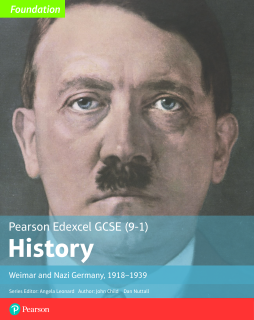
BOOK
Edexcel GCSE (9-1) History Foundation Weimar and Nazi Germany, 1918Ð39 Student Book
(2018)
Additional Information
Book Details
Abstract
Edexcel GCSE (9-1) History Foundation Weimar and Nazi Germany, 1918Ð39 Student Book
Table of Contents
| Section Title | Page | Action | Price |
|---|---|---|---|
| Front Cover | Front Cover | ||
| Contents | 3 | ||
| Timeline | 6 | ||
| Chapter 1: The Weimar Republic, 1918–29 | 8 | ||
| 1.1: The origins of the Republic, 1918–19 | 9 | ||
| The legacy of the First World War | 9 | ||
| The German revolution, 1918–19 | 10 | ||
| Setting up the Weimar Republic | 11 | ||
| The Weimar Constitution | 12 | ||
| The strengths and weaknesses of the Weimar Constitution | 13 | ||
| 1.2: Early challenges to the Republic, 1919–23 | 17 | ||
| Unpopularity of the Republic | 17 | ||
| The armistice | 17 | ||
| The Treaty of Versailles, 1919 | 17 | ||
| The impact of the treaty on the Weimar Republic | 19 | ||
| Challenges to the Weimar Republic from the Left and Right | 20 | ||
| The challenges of 1923 | 23 | ||
| 1.3: The recovery of the Republic, 1924–29 | 27 | ||
| Stresemann’s strategy | 27 | ||
| Reasons for economic recovery | 27 | ||
| Recovery in foreign relations | 29 | ||
| 1.4: Changes in society, 1924–29 | 33 | ||
| Changes in the standard of living | 33 | ||
| Changes for women in the Weimar Republic | 34 | ||
| Recap page | 39 | ||
| Writing Historically | 40 | ||
| Chapter 2: Hitler’s rise to power, 1919–33 | 42 | ||
| 2.1: Early development of the Nazi Party, 1920–22 | 43 | ||
| Hitler’s early career in politics | 43 | ||
| 2.2: Munich Putsch and lean years, 1923–29 | 49 | ||
| The Munich Putsch, 1923 | 49 | ||
| The lean years of the Nazi Party, 1924–28 | 55 | ||
| 2.3: Growth in Nazi support, 1929–32 | 59 | ||
| The Wall Street Crash in the USA | 59 | ||
| Unemployment – the impact on people | 60 | ||
| The failure to deal with unemployment | 61 | ||
| Rise in support for KPD and NSDAP | 61 | ||
| Why did people support the Nazi Party? | 62 | ||
| 2.4: How Hitler became Chancellor, 1932–33 | 67 | ||
| Political developments in 1932 | 68 | ||
| The roles of Hindenburg, von Schleicher and von Papen | 70 | ||
| Recap page | 73 | ||
| Chapter 3: Nazi control and dictatorship, 1933–39 | 74 | ||
| 3.1: The creation of a dictatorship, 1933–34 | 75 | ||
| The Reichstag Fire | 75 | ||
| The Enabling Act | 77 | ||
| Removing other opposition | 78 | ||
| The Night of the Long Knives | 79 | ||
| The death of Hindenburg | 81 | ||
| 3.2: The police state | 83 | ||
| Policing the police state | 83 | ||
| Controlling the legal system | 87 | ||
| Controlling religious views | 88 | ||
| 3.3: Controlling and influencing attitudes | 91 | ||
| Goebbels and propaganda | 91 | ||
| Nazi use of the media | 92 | ||
| Nazi use of rallies | 93 | ||
| Nazi use of sport | 94 | ||
| Nazi control of culture and the Arts | 95 | ||
| 3.4: Opposition, resistance and conformity | 99 | ||
| Support for the Nazi regime | 99 | ||
| Resistance and opposition | 100 | ||
| Opposition from churches | 100 | ||
| Opposition from the young | 102 | ||
| Recap page | 105 | ||
| Writing Historically | 106 | ||
| Chapter 4: Life in Nazi Germany, 1933–39 | 108 | ||
| 4.1: Nazi policies towards women | 109 | ||
| Nazi views on women and the family | 109 | ||
| Nazi policies towards women | 110 | ||
| 4.2: Nazi policies towards the young | 114 | ||
| The aims of Nazi policies concerning the young | 114 | ||
| The Nazi youth movement | 115 | ||
| Nazi youth groups for boys | 115 | ||
| The League of German Maidens | 117 | ||
| Did Nazi youth groups achieve Nazi aims? | 118 | ||
| Nazi control of the young through education | 119 | ||
| 4.3: Employment and living standards | 123 | ||
| Nazi policies to reduce unemployment | 123 | ||
| Changes in the standard of living | 126 | ||
| Nazi organisations which affected the standard of living of workers | 127 | ||
| 4.4: The persecution of minorities | 131 | ||
| Nazi racial beliefs and policies | 131 | ||
| The treatment of minorities | 133 | ||
| The persecution of Jews | 134 | ||
| Recap page | 139 | ||
| Explaining why historians’ interpretations differ | 140 | ||
| Historians focus on different things | 140 | ||
| Historians reach different conclusions from the evidence | 141 | ||
| Preparing for your exams | 142 | ||
| Answers | 154 | ||
| Index | 155 | ||
| Acknowledgements | 157 |
